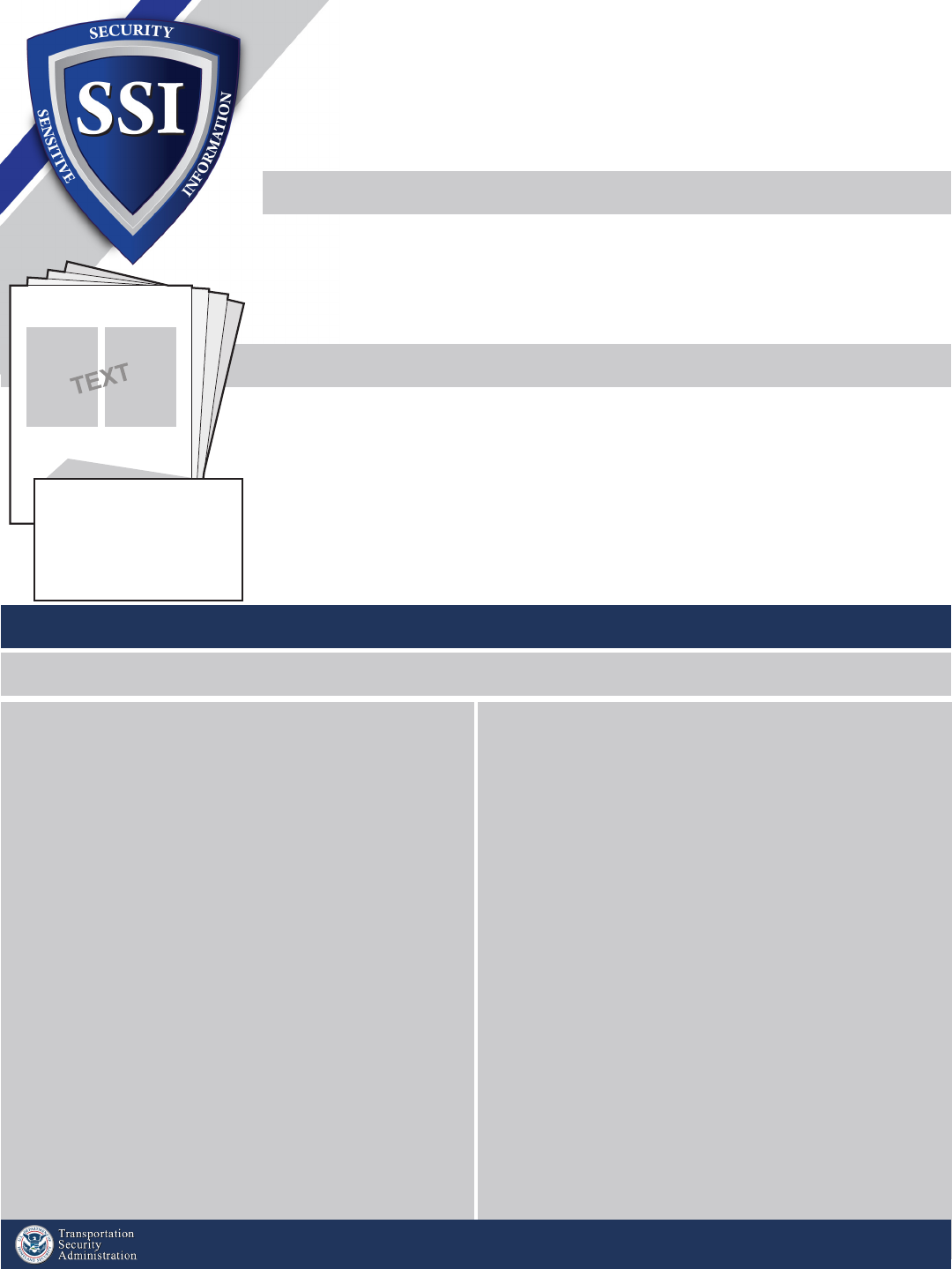
Best Practices Guide for Non-DHS Employees and Contractors
Sensitive Security Information
SSI Requirements
The SSI regulation mandates specic and general requirements for handling and protecting SSI.
You Must – Lock Up All SSI: Store SSI in a secure container such as a locked le cabinet or drawer (as
dened by Federal regulation 49 C.F.R. part 1520.9 (a)(1)).
You Must – When No Longer Needed, Destroy SSI: Destruction of SSI must be complete to preclude
recognition or reconstruction of the information (as dened by Federal regulation 49 C.F.R. part
1520.19).
You Must – Mark SSI: The regulation requires that even when only a small portion of a paper
document contains SSI, every page of the document must be marked with the SSI header and footer
shown at left (as dened by Federal regulation 49 C.F.R. part 1520.13). Alteration of the footer is not
authorized.
Use an SSI cover sheet on all SSI materials. Ì
Electronic presentations (e.g., PowerPoint) should be marked Ì
with the SSI header on all pages and the SSI footer on the
rst and last pages of the presentation.
Spreadsheets should be marked with the SSI header on Ì
every page and the SSI footer on every page or at the end
of the document.
Video and audio should be marked with the SSI header and Ì
footer on the protective cover when able and the header
and footer should be shown and/or read at the beginning
and end of the program.
CDs/DVDs should be encrypted or password-protected Ì
and the header and footer should be afxed to the CD/DVD.
Portable drives including “ash” or “thumb” drives should not Ì
themselves be marked, but the drive itself should be
encrypted or all SSI documents stored on it should be
password protected.
When leaving your computer or desk you must lock up all SSI Ì
and you should lock or turn off your computer.
Taking SSI home is not recommended. If necessary, get Ì
permission from a supervisor and lock up all SSI at home.
Don’t handle SSI on computers that have peer-to-peer Ì
software installed on them or on your home computer.
What is SSI?
Sensitive Security Information (SSI) is information that, if publicly released, would be detrimental to
transportation security, as dened by Federal regulation 49 C.F.R. part 1520.
Although SSI is not classied information, there are specic procedures for recognizing, marking,
protecting, safely sharing, and destroying SSI. As persons receiving SSI in order to carry out
responsibilities related to transportation security, you are considered “covered persons” under the SSI
regulation and have special obligations to protect this information from unauthorized disclosure.
The purpose of this hand-out is to provide transportation security stakeholders and non-DHS
government employees and contractors with best practices for handling SSI. Best practices are not
to be construed as legally binding requirements of, or ofcial implementing guidance for, the SSI
regulation.
Transmit SSI via email only in a password protected Ì
attachment, not in the body of the email. Send the password
without identifying information in a separate email or
by phone.
Passwords for SSI documents should contain at least eight Ì
characters, have at least one uppercase and one lowercase
letter, contain at least one number, one special character
and not be a word in the dictionary.
Faxing of SSI should be done by rst verifying the fax Ì
number and that the intended recipient will be available
promptly to retrieve the SSI.
SSI should be mailed by U.S. First Class mail or other Ì
traceable delivery service using an opaque envelope or
wrapping. The outside wrapping (i.e. box or envelope)
should not be marked as SSI.
Interofce mail should be sent using an unmarked, opaque, Ì
sealed envelope so that the SSI cannot be read through the
envelope.
SSI stored in network folders should either require a Ì
password to open or the network should limit access
to the folder to only those with a need to know.
Properly destroy SSI using a cross-cut shredder or by cutting Ì
manually into less than ½ inch squares.
Properly destroy electronic records using any method that Ì
will preclude recognition or reconstruction.
Best Practices Guide
Reasonable steps must be taken to safeguard SSI. While the regulation does not dene reasonable steps, the TSA SSI Branch offers
these best practices as examples of reasonable steps:
SENSITIVE SECURITY
INFORMATION
Safely Sharing Information
Phone: (571) 227-3513 • Fax: (571) 227-2945
WARNING: This record contains Sensitive Security
Information that is controlled under 49 CFR parts
15 and 1520. No part of this record may be
disclosed to persons without a “need to know,”
as defined in 49 CFR parts 15 and 1520, except
with the written permission of the Administrator
of the Transportation Security Administration or
the Secretary of Transportation. Unauthorized
release may result in civil penalty or other action.
For U.S. government agencies, public disclosure
is governed by 5 USC 552 and 49 CFR parts 15
and 1520.
www.tsa.gov
